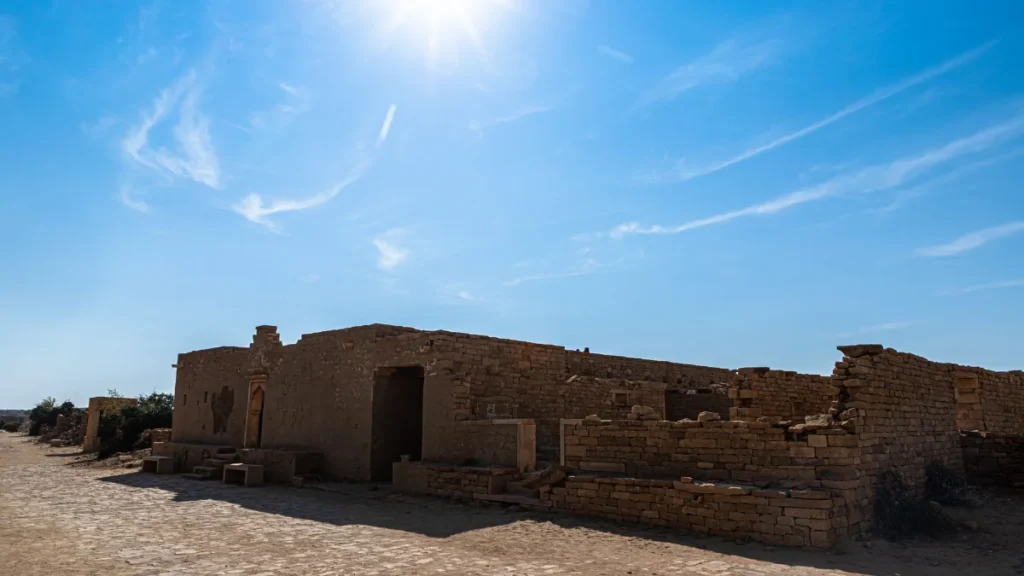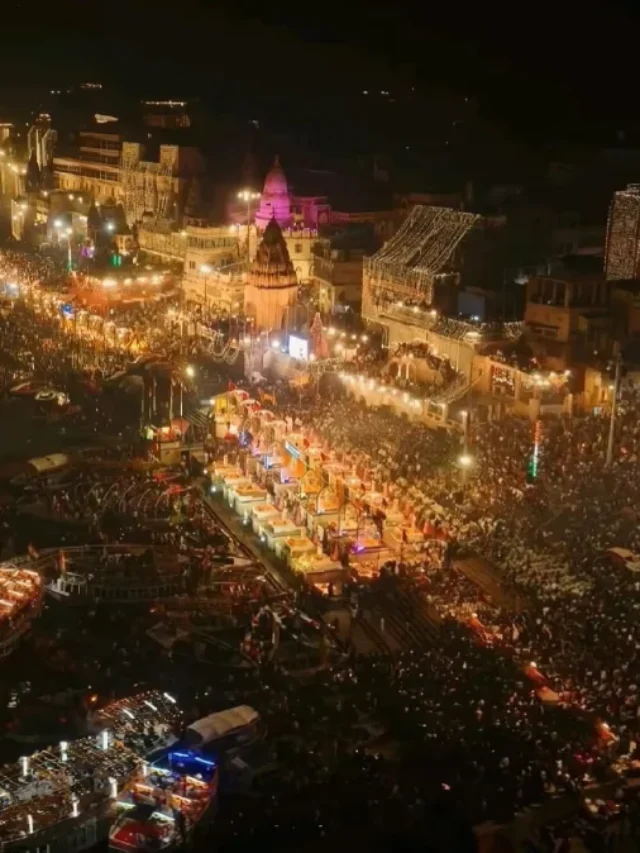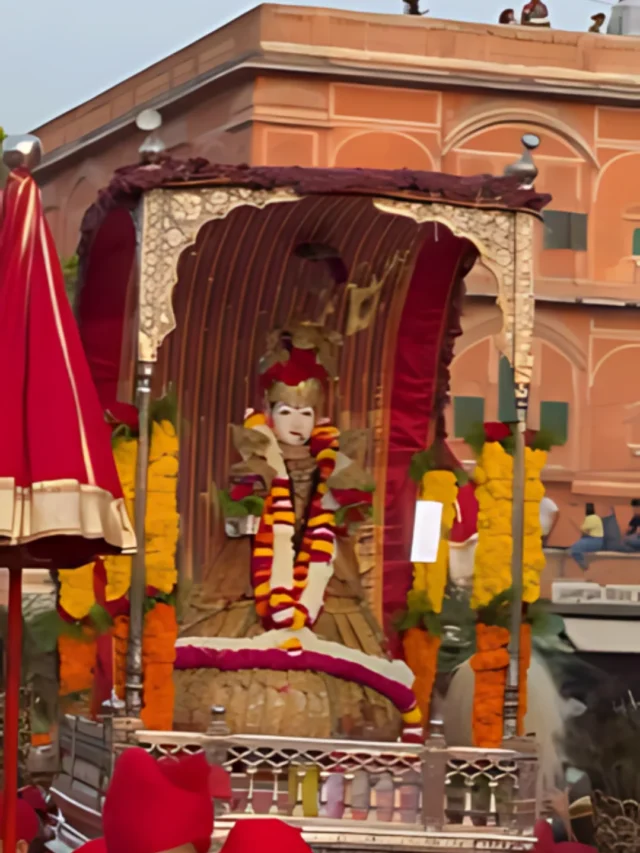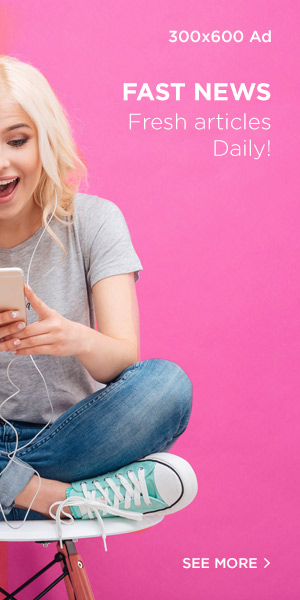Have you ever been drawn in by the appeal of cryptic places, unexplored landscapes, hidden settlements, and the intriguing stories and legends that surround them? If so, a trip to Kuldhara Village near Jaisalmer can satisfy your interest. Kuldhara Village, an abandoned historical monument in Rajasthan’s Thar Desert, has captured the attention of people all over the world. The community has an intriguing past that is covered in a lot of mystery and intrigue.
About Kuldhara Village’s Haunted Past
Located 17 km west of Jaisalmer, Kuldhara has a fascinating story that spans over 300 years. Once a prosperous village of Paliwal Brahmins under Jaisalmer’s rule, its history is entwined with that of Salim Singh, the state’s powerful and scandalous prime minister.
According to legend, Salim Singh was enamoured with the local chief’s daughter and tried to marry her forcefully. He put the community in fear of dire repercussions if his demands were not fulfilled. Instead of following the tyrant’s orders, the Paliwals met, and people from 85 villages left their ancestral homes and vanished into thin air. They cursed Kuldhara before they left, stating that no one would ever again reside in their abandoned village. After its inhabitants departed centuries ago, Kuldhara remained abandoned and appeared to be stuck in the past. There are several reports of paranormal activity, including people being frightened away by unexplained phenomena when they try to remain over.
On the other hand, a more practical interpretation contends that Salim Singh’s excessive taxes made village life unfeasible, forcing the people to relocate to more favourable areas. But the old myth still has charm since it gives the village’s past a hint of romance and mystery.
Inside Kuldhara: The Architecture Marvel Dating Back Centuries

Beyond its eerie reputation, Kuldhara Village in Jaisalmer is a captivating sight that showcases extraordinary architectural creativity and cultural history. The community, which has been abandoned for more than 200 years, has withstood the unrelenting passage of time, and its structures still stand as sturdy reminders of a bygone period.
It’s evident as soon as you arrive in Kuldhara how well it has been preserved. Even in this desolate place, the buildings have been tenderly stabilised to stave off the looming threat of collapse, and the streets have been painstakingly cleaned of rubbish. This meticulous attention to the physical remains of the hamlet indicates a steadfast commitment to conserving the heritage of the Paliwal Brahmins who originally lived in Kuldhara.
The structures of Kuldhara, which are made of the rich sandstone found in the area, are more than just remnants; they are enduring examples of the artistry and artistry of their previous occupants. Built to survive the harsh grip of the Thar Desert, the constructions include small windows and sturdy walls that cleverly control the internal temperature, offering a refreshing break from the intense heat of the desert. Intricate carvings and frescoes that pay homage to the artistic sensibilities of a bygone period embellish the buildings beyond their functional purpose, giving the sun-baked exterior layers of beauty and elegance.
The thoughtful utilisation of little streets and alleyways is the pinnacle of Kuldhara’s architectural beauty. These narrow passageways create a maze-like network that winds through the settlement, reflecting both practicality and a mysterious quality. In addition to offering much-needed shade and ventilation in the desert climate, they represent a serious obstacle to strangers trying to figure out the village’s complicated architecture. The spirit of Kuldhara’s history comes to life in these little lanes, beckoning investigation and introspection.
Furthermore, these alleyways were essential to Kuldhara’s social structure and served more purposes than just being utilitarian. In addition to its architectural value, they gave the villagers a feeling of protection and seclusion. The community took comfort in the protective embrace of the little streets, developing a special kinship that extended beyond the village’s physical features. The occupants could go through a network of connected walkways that provided a safe refuge where they could reconcile their private lives with community living.
Returning to Kuldhara reveals not just a community stuck in time but also a vibrant example of the inventiveness and resiliency of people. Every immaculate structure, every street that has been cleared, and the thoughtful arrangement of the little lanes all contribute to the narrative of a town that has survived, persevered, and finally left an enduring imprint on the passing of time. The timeless architecture of Kuldhara carries the echoes of the life of the Paliwal Brahmins, beckoning contemporary tourists to experience the mysterious beauty of a village that has stood the test of time.
The historical significance of Kuldhara Village in Jaisalmer’s annals is further enhanced by its mysterious abandonment. The community, which was once a hive of trade and commerce, benefited greatly from the agricultural, textile, and metalworking abilities of its residents, especially the skilled Paliwal Brahmins. This community, well-known for its academic endeavours, made a lasting impression on the region’s intellectual and cultural fabric.
Kuldhara Village has developed into a popular tourist site in Jaisalmer, drawing tourists from all over the world. Its eerie remains, surrounded by captivating desert vistas, provide a singular and unforgettable experience. The village appeals to anyone who enjoys history, photography, or going off the main path, even if it lacks modern conveniences. Kuldhara is a fascinating destination for modern travellers looking to experience the remnants of the past as well as a monument to its rich history.
Today’s Kuldhara Village

Kuldhara Village, which is presently under the Archaeological Survey of India’s (ASI) protection as a historical monument, is receiving careful upkeep and restoration. Considerable work has been done to preserve this ancient property in the last several years. Remarkably, a good chunk of an old temple, tucked away in a row of homes, has been tastefully restored. After climbing a neat series of steps, guests are now greeted within the temple, where the walls still have traces of tiny niches that formerly held little lamps.
The atmosphere of the stopped time is palpable as soon as one enters the settlement. Frozen in an abandoned state with crumbling homes and no human activity, Kuldhara is nevertheless a heartbreaking testimony to the passing of two centuries. The remains of over 410 structures in the town, which are shrouded in mystery and tradition, reveal its narrative. The lower township, which was beyond the settlement, was made up of 200 more buildings.
Previous visitors have described Kuldhara’s terrain as devoid of economic activity and marked by sparse vegetation. Its pristine desolation is what makes it so alluring. The restored temple, surrounded by rubble, serves as a visual reminder of the continuous attempts to preserve and restore the historical authenticity of this once-vibrant community. With its view into a bygone age when time seems to have stopped for the previous 200 years, Kuldhara beckons exploration.
Kuldhara Tourism

At Kuldhara Village, tour guides who are sensitive to tourists’ curiosity dispel the locals’ disappearance tales and stories. The restored homes act as palpable reminders of the past, providing information about the layout of the hamlet and inspiring speculation about what Kuldhara may have been. Wandering around the designs, visitors may discover the wonderful architecture that was previously thriving in these dwellings.
Past the run-down buildings and a peculiar umbrella-shaped structure, tourists may go across lonely, dusty roads to find the village’s many deep step-wells. Every well appeared to cater to a certain group of inhabitants, and they were all encircled by pillars that were painted with images of gods and goddesses, including the well-known Ganesha. Although the precise meaning of these pillars is still unclear, they add to the mystery surrounding Kuldhara.
The public-private cooperation between Jindal Steel Works and the Rajasthan government marked the beginning of Kuldhara’s active growth as a tourism destination in 2015. The all-inclusive proposal calls for the construction of retail stores, a café, a lounge, a folk dance performance space, and nightly cabins.
There is still a sense of mystery in spite of these advancements. Overnight stays require special approval from the village caretakers. The gates of Kuldhara close, and the settlement is closed to visitors as the sun sets behind the dunes. The deeply rooted traditional concept of the area holds that ghosts continue to roam the hamlet after sundown, enveloping Kuldhara in a mystical ambience that surpasses the limits of contemporary progress.
When to Visit Kuldhara Village
The best months to visit Kuldhara Village are October through March, when the temperature is comfortable, and tourists may explore the village’s historical and architectural treasures without having to deal with intense heat. On the other hand, despite the erratic weather, the monsoon season from July to September provides a more daring experience. This time of year has a special attraction since Kuldhara is decked up in vivid colours, which makes for a beautiful scene, even with the odd downpour posing a possible problem. Depending on personal tastes, one may choose to go during the monsoon season, which offers more visual appeal and adventure, or during the comfortable and temperate winter.

Kuldhara Entry Fees and Timings
Daily hours for Kuldhara Village are 8 AM to 6 PM. Indian citizens must pay an admission charge of Rs. 10, while international nationals must pay Rs. 100. For Indian people, there is an extra charge of Rs. 50 if they want to drive their automobiles inside the hamlet. These rules aid in the upkeep and protection of the village’s historical and cultural treasures while making it easier for visitors to explore them.

How to Reach Kuldhara Village
By Air: Kuldhara Village is located around 17 kilometres away from Jaisalmer Airport, the nearest domestic airport. This airport has flights to Delhi, Jaipur, and Jodhpur. The Jodhpur Airport, which is around 330 miles distant, is a good choice for tourists from outside.
By Train: The closest railway station is Jaisalmer Railway Station, which is located around 34 miles from Kuldhara. For easy access to the village after arriving at the station, guests can choose to take a private cab from top Jaisalmer car rental firms.
By Road: Since Kuldhara Village is well-connected via road, driving there is a feasible choice. Tourists can choose from a variety of options, such as taxis, buses, and private cars.
Conclusion
Kuldhara Village, tucked away in the centre of Jaisalmer, is a hauntingly beautiful tribute to mystery and history. The Paliwal Brahmins’ outstanding architectural creations showcase their inventiveness and expertise, while the village’s winding lanes provide residents with a feeling of seclusion and safety.
Kuldhara’s mystery is further enhanced by the myriad ideas and traditions that have been generated by the mystery surrounding the villagers’ disappearance. This settlement is mysterious and eerie, yet it begs investigation and interest. On your next visit to Jaisalmer, you should not miss its crumbling yet alluring charm, which promises a trip down memory lane and an encounter that evokes the memories of a bygone age.







